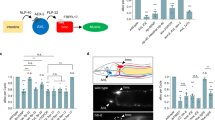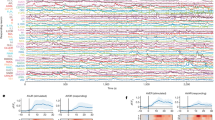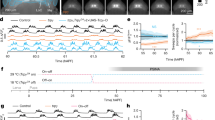Abstract
STIMULATION of transient increases in intracellular calcium (Cai2+) activates protein kinases1–3, regulates transcription4–9 and influences motility and morphology10–12. Developing neurons generate spontaneous Cai2+ transients, but their role in directing neuronal differentiation and the way in which they encode information are unknown. Here we image Ca2+ in spinal neurons throughout an extended period of early development, and find that two types of spontaneous events, spikes and waves, are expressed at distinct frequencies. Neuronal differentiation is altered when they are eliminated by preventing Ca2+ influx. Reimposing different frequency patterns of Ca2+ elevation demonstrates that natural spike activity is sufficient to promote normal neurotransmitter expression and channel maturation, whereas wave activity is sufficient to regulate neurite extension. Suppression of spontaneous Ca2+ elevations by BAPTA loaded intracellularly indicates that they are also necessary for differentiation. Ca2+ transients appear to encode information in their frequency, like action potentials, although they are 104 times longer in duration and less frequent, and implement an intrinsic development programme.
This is a preview of subscription content, access via your institution
Access options
Subscribe to this journal
Receive 51 print issues and online access
$199.00 per year
only $3.90 per issue
Buy this article
- Purchase on Springer Link
- Instant access to full article PDF
Prices may be subject to local taxes which are calculated during checkout
Similar content being viewed by others
References
Colbran, R. J. & Soderling, T. R. Curr. Top. Cell Regulation 31, 181–221 (1990).
Braha, O., Edmonds, B., Sacktor, T., Kandel, E. R. & Klein, M. J. Neurosci. 13, 1839–1851 (1993).
Ghosh, A., Carnahan, J. & Greenberg, M. E. Science 263, 1618–1623 (1994).
Sheng, M., McFadden, G. & Greenberg, M. E. Neuron 4, 571–582 (1990).
Dash, P. K., Karl, K. A., Colicos, M. A., Prywes, R. & Kandel, E. R. Proc. natn. Acad. Sci. U.S.A. 88, 5061–5065 (1991).
Lerea, L. S. & McNamara, J. O. Neuron 10, 31–41 (1993).
Bading, H., Ginty, D. D. & Greenberg, M. E. Science 260, 181–186 (1993).
Enslen, H. et al. J. biol. Chem. 269, 15520–15527 (1994).
Sheng, H. Z., Fields, R. D. & Nelson, P. G. J. Neurosci. Res. 35, 459–467 (1993).
Cohan, C. S. & Kater, S. B. Science 232, 1638–1640 (1986).
Cline, H. T. & Tsien, R. W. Neuron 6, 259–267 (1991).
Fields, R. D., Neale, E. A. & Nelson, P. G. J. Neursoci. 10, 2950–2964 (1990).
Desarmenien, M. G. & Spitzer, N. C. Neuron 7, 797–805 (1991).
Spitzer, N. C., Debaca, R. C., Allen, K. A. & Holliday, J. J. comp. Neurol. 337, 168–175 (1993).
Bixby, J. L. & Spitzer, N. C. Devl Biol. 106, 89–96 (1984).
Holliday, J. & Spitzer, N. C. Devl Biol. 141, 13–23 (1990).
Holliday, J., Adams, R. J., Sejnowski, T. J. & Spitzer, N. C. Neuron 7, 787–796 (1991).
Gu, X., Olson, E. C. & Spitzer, N. C. J. Neurosci. 14, 6325–6335 (1994).
Shatz, C. J. Neuron 5, 745–756 (1990).
Kocsis, J. D., Rand, M. N., Lankford, K. L. & Waxman, S. G. J. Neurobiol. 25, 252–264 (1994).
Rink, T. J. & Jacob, R. Trends Neurosci. 12, 43–46 (1989).
Meyer, T. & Stryer, L. A. Rev. Biophys. biophys. Chem. 20, 153–174 (1991).
Turrigiano, G., Abbott, L. F. & Marder, E. Science 264, 974–977 (1994).
Yuste, R., Peinado, A. & Katz, L. C. Science 257, 665–669 (1992).
Komuro, H. & Rakic, P. Science 257, 806–809 (1992).
Komuro, H. & Rakic, P. Science 260, 95–97 (1993).
Poenie, M., Alderton, J., Tsien, R. Y. & Steinhardt, R. A. Nature 315, 147–149 (1985).
Flucher, B. E. & Andrews, S. B. Cell Motil. Cytoskel. 25, 143–157 (1993).
Fatatis, A. & Russell, J. T. Glia 5, 95–104 (1992).
Nieuwkoop, P. D. & Faber, J. Normal Table of Xenopus laevis 2nd edn (North Holland, Amsterdam, 1967).
Author information
Authors and Affiliations
Rights and permissions
About this article
Cite this article
Gu, X., Spitzer, N. Distinct aspects of neuronal differentiation encoded by frequency of spontaneous Ca2+ transients. Nature 375, 784–787 (1995). https://doi.org/10.1038/375784a0
Received:
Accepted:
Issue Date:
DOI: https://doi.org/10.1038/375784a0
This article is cited by
-
Calcium signalling pathways in prostate cancer initiation and progression
Nature Reviews Urology (2023)
-
Structural titration reveals Ca2+-dependent conformational landscape of the IP3 receptor
Nature Communications (2023)
-
Endoplasmic Reticulum in Metaplasticity: From Information Processing to Synaptic Proteostasis
Molecular Neurobiology (2022)
-
High-throughput kinase inhibitor screening reveals roles for Aurora and Nuak kinases in neurite initiation and dendritic branching
Scientific Reports (2021)
-
Calcium Dynamics and Water Transport in Salivary Acinar Cells
Bulletin of Mathematical Biology (2021)
Comments
By submitting a comment you agree to abide by our Terms and Community Guidelines. If you find something abusive or that does not comply with our terms or guidelines please flag it as inappropriate.



